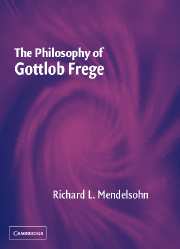Book contents
- Frontmatter
- Contents
- List of Principles
- Preface
- 1 Biography
- 2 Function and Argument
- 3 Sense and Reference
- 4 Frege's Begriffsschrift Theory of Identity
- 5 Concept and Object
- 6 Names and Descriptions
- 7 Existence
- 8 Thought, Truth Value, and Assertion
- 9 Indirect Reference
- 10 Through the Quotation Marks
- Appendix A Begriffsschrift in Modern Notation: (1) to (51)
- Appendix B Begriffsschrift in Modern Notation: (52) to (68)
- Notes
- Bibliography
- Index
10 - Through the Quotation Marks
Published online by Cambridge University Press: 28 July 2009
- Frontmatter
- Contents
- List of Principles
- Preface
- 1 Biography
- 2 Function and Argument
- 3 Sense and Reference
- 4 Frege's Begriffsschrift Theory of Identity
- 5 Concept and Object
- 6 Names and Descriptions
- 7 Existence
- 8 Thought, Truth Value, and Assertion
- 9 Indirect Reference
- 10 Through the Quotation Marks
- Appendix A Begriffsschrift in Modern Notation: (1) to (51)
- Appendix B Begriffsschrift in Modern Notation: (52) to (68)
- Notes
- Bibliography
- Index
Summary
Introduction
We usually use language to speak about things other than itself. Of course, we can use language to speak about itself. The single-quote construction was devised for just this purpose, to render such speaking error free. The construction has the important characteristic that the very expression named is woven into the fabric of the sentence used to speak about it. To forestall errors of ambiguity, then, the construction takes upon itself the onus of ambiguity to assure clarity elsewhere.
The single-quote convention is to enclose a word or phrase in single quotation marks when we wish to speak about it. The convention was introduced into modern practice originally by Frege (1892c: 153–4), whose strategy was to treat direct quotation and indirect quotation in a parallel manner:
If words are used in the ordinary way, what one intends to speak of is their Bedeutung. It can also happen, however, that one wishes to talk about the words themselves or their sense. This happens, for instance, when the words of another are quoted. One's own words then first designate [bedeuten] words of the other speaker, and only the latter have their usual Bedeutung.We then have signs of signs. In writing, the words are in this case enclosed in quotation marks. Accordingly, a word standing between quotation marks must not be taken as having its ordinary Bedeutung.
This passage immediately precedes the one with which we opened Chapter 9 and introduced the notions of customary and indirect reference.
- Type
- Chapter
- Information
- The Philosophy of Gottlob Frege , pp. 163 - 184Publisher: Cambridge University PressPrint publication year: 2005



